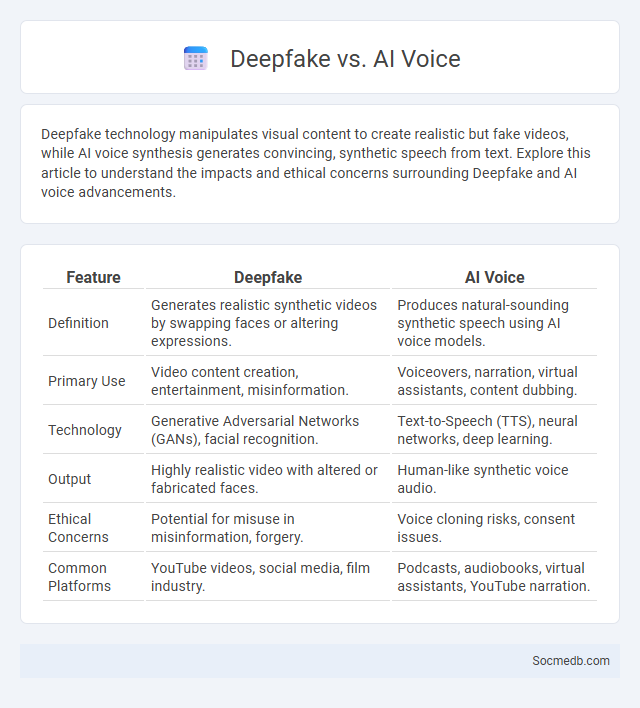
Photo illustration: Deepfake vs AI Voice
Deepfake technology manipulates visual content to create realistic but fake videos, while AI voice synthesis generates convincing, synthetic speech from text. Explore this article to understand the impacts and ethical concerns surrounding Deepfake and AI voice advancements.
Table of Comparison
| Feature | Deepfake | AI Voice |
|---|---|---|
| Definition | Generates realistic synthetic videos by swapping faces or altering expressions. | Produces natural-sounding synthetic speech using AI voice models. |
| Primary Use | Video content creation, entertainment, misinformation. | Voiceovers, narration, virtual assistants, content dubbing. |
| Technology | Generative Adversarial Networks (GANs), facial recognition. | Text-to-Speech (TTS), neural networks, deep learning. |
| Output | Highly realistic video with altered or fabricated faces. | Human-like synthetic voice audio. |
| Ethical Concerns | Potential for misuse in misinformation, forgery. | Voice cloning risks, consent issues. |
| Common Platforms | YouTube videos, social media, film industry. | Podcasts, audiobooks, virtual assistants, YouTube narration. |
Introduction to Deepfake and AI Voice Technologies
Deepfake and AI voice technologies use advanced machine learning algorithms to create highly realistic synthetic images, videos, and audio that can convincingly mimic real people. These tools have transformed social media by enabling the generation of content that blurs the line between authentic and fabricated media, raising concerns about misinformation and digital trust. Understanding how these technologies work helps you critically evaluate the content you encounter and protect your online interactions from potential manipulation.
Understanding the Difference: Deepfake vs AI Voice
Deepfake technology manipulates visual and audio content to create highly realistic but fake media, often altering a person's appearance or actions, while AI voice synthesis generates synthetic speech that mimics a real person's voice based on audio data. Understanding the difference is essential for protecting Your digital identity and discerning authentic content on social media platforms. Both technologies pose unique challenges for misinformation, requiring vigilance and awareness to spot manipulated videos versus synthesized voices.
How Deepfake Technology Works
Deepfake technology utilizes advanced machine learning algorithms, particularly generative adversarial networks (GANs), to create hyper-realistic synthetic media by swapping faces or altering voices in images and videos. These algorithms are trained on vast datasets of audiovisual content to learn and mimic user-specific facial expressions, speech patterns, and mannerisms. The resulting deepfakes can convincingly manipulate social media content, posing challenges for authenticity and misinformation detection across platforms like Instagram, TikTok, and Facebook.
How AI Voice Synthesis Operates
AI voice synthesis operates by converting text into natural-sounding speech using deep learning models and neural networks that analyze linguistic patterns and phonetic nuances. Advanced algorithms generate intonation, rhythm, and emotion to create human-like audio output, enhancing user engagement on social media platforms. This technology enables personalized voice messages, automated responses, and immersive content, transforming digital communication experiences.
Key Applications of Deepfake in Media and Entertainment
Deepfake technology revolutionizes media and entertainment by enabling realistic digital character creation, enhancing visual effects in movies, and facilitating voice cloning for dubbing and voiceovers. It allows filmmakers to de-age actors or resurrect deceased performers, expanding storytelling possibilities without physical constraints. Advertising leverages deepfakes for personalized content, while video game developers use the technology for lifelike in-game characters and immersive experiences.
Use Cases for AI Voice in Business and Communication
AI voice technology enhances customer service by enabling instant, personalized interactions through chatbots and virtual assistants, reducing response times and operational costs. Your business can leverage AI voice for automated transcription and real-time translation, streamlining communication across global teams and improving collaboration. Voice analytics also provide valuable insights into customer sentiment and behavior, helping you tailor marketing strategies and improve user experience.
Ethical Concerns: Deepfake and AI Voice Risks
Deepfake technology and AI-generated voices pose significant ethical concerns in social media, as they enable the creation of highly realistic but fabricated content that can deceive users and spread misinformation. These artificially manipulated images and audio clips can threaten privacy, damage reputations, and escalate the risk of fraud and identity theft. Addressing these risks requires advanced detection tools, regulatory frameworks, and increased public awareness to ensure digital integrity and trust on social media platforms.
Detection and Prevention of Deepfake and AI Voice Fraud
Advanced AI algorithms enable the detection and prevention of deepfake videos and AI voice fraud on social media platforms by analyzing inconsistencies in facial movements and audio patterns. Your safety is enhanced through real-time monitoring systems that flag suspicious content, reducing the risk of misinformation and identity theft. Machine learning models continuously improve accuracy, ensuring evolving threats are identified quickly and effectively.
Legal Implications and Regulatory Responses
Social media platforms face increasing legal implications regarding data privacy, misinformation, and user content liability, with regulations like the GDPR and the Digital Services Act enforcing stricter compliance. Your online activities are subject to these evolving laws, which mandate transparency, content moderation, and accountability from social media companies. Regulatory responses continue to adapt, aiming to balance free expression with the protection of user rights and prevention of harmful digital practices.
The Future of Deepfake and AI Voice Technologies
Deepfake and AI voice technologies are advancing rapidly, enhancing realism and personalization in digital content creation. Your interactions on social media platforms will increasingly feature hyper-realistic video and audio snippets that challenge authenticity and demand vigilant verification tools. Innovations in AI-driven synthetic media will transform user engagement, marketing strategies, and online security protocols, shaping the future landscape of digital communication.
 socmedb.com
socmedb.com